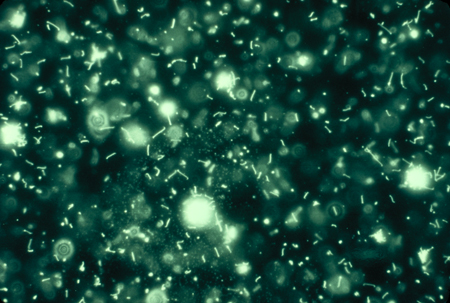Summary
Definition
ანამნეზი და გასინჯვა
ძირითადი დიაგნოსტიკური ფაქტორები
- high remittent fever
- headache
- myalgia
- conjunctival suffusion
- muscle tenderness
სხვა დიაგნოსტიკური ფაქტორები
- chills or rigors
- abdominal pain
- nausea or vomiting
- diarrhea
- asthenia
- anorexia
- photophobia
- eye pain
- neck stiffness
- cough
- dyspnea
- chest pain
- hemoptysis
- oliguria or polyuria
- cardiac arrhythmias
- lymphadenopathy
- splenomegaly
- hepatomegaly
- jaundice
- adenopathy
- mental status changes
- morbilliform rash
რისკფაქტორები
- contact (direct or indirect) with urine of infected animals
- residence in or travel to an endemic area
- residence in or travel to an area with recent flooding
- involvement in water sports
- poor living conditions/lack of sanitation
დიაგნოსტიკური კვლევები
1-ად შესაკვეთი გამოკვლევები
- CBC and differential
- urinalysis
- microscopic agglutination test (MAT)
- enzyme-linked immunosorbent assay (ELISA)
- polymerase chain reaction (PCR)
- darkfield examination
- blood culture
- cerebrospinal fluid (CSF) culture
- ECG
- chest x-ray
- LFTs
- conjugated bilirubin
- metabolic profile
- serum pancreatic enzymes
- CSF analysis
გასათვალისწინებელი კვლევები
- urine culture
- renal biopsy
- lung biopsy
- staining methods
- latex agglutination
- western blot
- quantitative PCR
ახალი ტესტები
- lateral flow assays
- cytokines
მკურნალობის ალგორითმი
mild disease
moderate to severe disease
კონტრიბუტორები
ავტორები
John Fournier, MD
Clinical Fellow
Infectious Disease Section
Yale School of Medicine
New Haven
CT
გაფრთხილება:
JF declares that he has no competing interests.
Albert I. Ko, MD
Professor of Epidemiology and Medicine
Department Chair
Epidemiology of Microbial Diseases
Yale School of Public Health
New Haven
CT
გაფრთხილება:
AIK serves as an expert panel member for the Reckitt Global Hygiene Institute and a Board of Directors member for the American Society of Tropical Medicine. He has received grants from Zoetis and has patents which have been awarded and submitted for use in developing diagnostics and vaccines for leptospirosis.
მადლიერება
Dr John Fournier and Dr Albert I. Ko would like to gratefully acknowledge Dr Nilmarie Guzman, a previous contributor to this topic.
გაფრთხილება:
NG declares that she has no competing interests.
რეცენზენტები
Carmen Isache, MD
Assistant Professor of Medicine
Infectious Disease Division
University of Florida College of Medicine
Jacksonville
FL
გაფრთხილება:
CI declares that she has no competing interests.
Andreas Jansen, MD, DTM
Scientific Officer
Robert Koch Institute
Department for Infectious Disease Epidemiology
Gastrointestinal Infections
Zoonoses and Tropical Infections Unit
Berlin
Germany
გაფრთხილება:
AJ declares that he has no competing interests.
Sean V. Shadomy, DVM, MPH
Epidemiologist
Bacterial Zoonoses Branch
DFBMD/NCZVED/CCID
Centers for Disease Control and Prevention
Atlanta
GA
Declarações
SVS declares that he has no competing interests.
Créditos aos pareceristas
Os tópicos do BMJ Best Practice são constantemente atualizados, seguindo os desenvolvimentos das evidências e das diretrizes. Os pareceristas aqui listados revisaram o conteúdo pelo menos uma vez durante a história do tópico.
Declarações
As afiliações e declarações dos pareceristas referem--se ao momento da revisão.
Referências
Principais artigos
Levett P. Leptospirosis. In: Mandell, Douglas, and Bennett's principles and practice of infectious diseases. 6th ed. Philadelphia, PA: Churchill Livingstone; 2006:2495-500.
Vijayachari P, Sugunan AP, Shriram AN. Leptospirosis: an emerging global, public health problem. J Biosci. 2008 Nov;33(4):557-69. Resumo
World Health Organization. Human leptospirosis: guidance for diagnosis, surveillance and control. Geneva: World Health Organization; 2003.Texto completo
Centers for Disease Control and Prevention: National Notifiable Diseases Surveillance System (NNDSS). Leptospirosis (Leptospira interrogans) 2013 case definition. Apr 2021 [internet publication].Texto completo
Artigos de referência
Uma lista completa das fontes referenciadas neste tópico está disponível para os usuários com acesso total ao BMJ Best Practice.

Diagnósticos diferenciais
- Hantavirus cardiopulmonary syndrome
- Dengue fever
- Malaria infection
Mais Diagnósticos diferenciaisDiretrizes
- CDC Yellow Book: health information for international travel - leptospirosis
- Fever in returned travellers presenting in the United Kingdom: recommendations for investigation and initial management
Mais DiretrizesConectar-se ou assinar para acessar todo o BMJ Best Practice
O uso deste conteúdo está sujeito ao nosso aviso legal